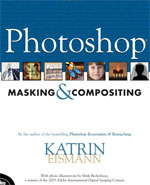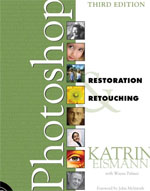When I work hard on photos for someone and get a thanks like this, it really makes my day!

Testing your camera’s color exposure latitude is a key to getting good color in your digital photographs. This is a sequel to The Best Colors Come From the Best Exposures. I would suggest you read that article first.
When it comes to your digital camera, the better your metering skills, the better your colors will be. If you learn how to master exposure, you will get the best possible colors your camera is capable of producing. Why not put your camera on auto exposure and then correct the exposure on the computer? Because you won’t get the best colors. In auto exposure mode your camera is designed to give you average exposures, not the best exposures. This is very important: If you don’t nail the exposure in the camera, the colors in a photo will shift in different directions and no amount of computer work will bring them back. This is one of the best kept secrets of great color and it is why professional landscape, fashion, and advertising photographers are obsessive about exposure. There is no getting around mastering exposure if you want great color.
A business headshot requires pretty even lighting.This portrait was created with three studio lights against a black backdrop, a main light, a fill light, and a hair light.
My first YouTube video. I did a video screen capture of a 90 minute retouching job and sped up the video 16x to a little over 6 minutes (not counting opening and closing titles). Watch it here or see a larger version at YouTube.
Question:Â “I’m looking at photography courses online. The courses are free but some require students to own or have access to various versions of Photoshop. Does anyone know if Photoshop 6 is the same as Photoshop CS6?”
One of the things I like about winter is the sunlight streaming through one of my studio windows at a low enough angle to create window blind shadows portraits. In the summer the sun is too high for me to do this and get the angles I want.
I never thought I would sell prints from my iPhone. I was wrong.
There are serious challenges to photographing city lights at night from a commercial jet. Here are some suggestions that will help.
I was getting impatient as our flight was delayed over an hour. I was anxious to get a photo of the Las Vegas Strip from the air before the sun set. But impatience turned to gratitude when our delay made this photo possible.
This was created three years ago but it is still very funny and well done. If you have ever mumbled and grumbled about the price of a high end digital camera, this is for you.
How do you photograph the Milky Way, that milky band of light across the night sky that has our galaxy’s brightest concentration of light? With a wide angle lens and a tripod it is simple if you know a few tricks. Finding a dark enough sky is more of a problem.
The snow in a winter scene will often fool a camera meter into underexposing a photo, so here are the steps to take to get the right exposure. I throw in a few portrait suggestions too.
Metering dark toned wildlife in the snow is a major exposure challenge. It is usually best to avoid large “burned out” areas (washed out, featureless white) in a nature or landscape photograph, but with properly exposed snow, the wildlife can be so dark as to lose all texture. On other hand, metering for the wildlife can burn out the snow.
(Originally written Nov. 19, 2012. Most recent update: Jan. 16, 2013.)Â Â It’s that time of year. The holiday season is here and I am getting the usual questions about which digital cameras I recommend. The camera lists below will point you to the highest rated models. There is also some information and advice on choosing a camera. The lists will be updated throughout the holiday season as new, highly rated cameras become available.
Just like metering daytime winter scenes, the key to metering evening winter scenes is knowing what to meter and deciding how much exposure compensation to use.
Metering for scenes with a lot of snow can be tricky since the snow fools the camera meter. I see a lot of winter photos online with gray, underexposed snow, which means the camera meter did what it was designed to do and the camera owner didn’t know how to use exposure compensation. The solution is quite simple provided you know what to do.
Bad weather can lead to great sunsets. It was rainy day with a leaden gray sky when I picked up my coat, photo backpack and tripod to leave the “fireplace room” at the bed and breakfast in Banff. Some of the other guests asked if I really expected to get any good pictures in the bad weather. “I hope so!”
You are online and to your surprised yo see a photo of one of your children in an ad for a product you don’t approve of. How could this happen? Do you use Instagram? As of January 16, 2013, Instagram claims the right to sell your photos to anyone they choose without paying you or notifying you. You will have no control over who the photos are sold to or how they will be used. And you won’t be notified.
The Popular Photography magazine article in my December 12 post is now online. The editors picked the Canon 5D Mark III, the Nikon D800, and the Sony Alpha 99 as the three best cameras of 2012, with the Canon as the winner. The honorable mentions are the Fuji X-Pro 1 and the Olympus OM-D EM-5.
Can a world class, National Geographic photographer lose his passion? Yes! How does he get it back?
Looking for the best photo gifts for a photographer? You’ve come to the right place. I have dozens of gift recommendations with prices starting at less than $4.
Originally shot in HD and resized for the web, this will give you an idea what the Canon 5D Mark III is capable of doing.
According to Popular Photography magazine, the Canon EOS 5D Mark III is “the best low-light DSLR we have yet tested. A near perfect tool for the still shooter, it can double as a top gun for the videographer” (Jan 2013 issue, p. 58). Pop Photo‘s top three cameras for 2012, all full frame digital SLRs, are the Canon 5D Mark III, the Nikon D800, and the Sony Alpha 99. So why did they pick the 5D MkIII as the best of the best?
I finally found an excellent series of photography lessons on video to complement my book, Digital Photography Exposure for Dummies, and it is by Joel Sartore, a first class photographer who does a lot of work for National Geographic. He does stunning photography in amazing situations all over the world. You can see some of his work in the galleries at his web site.
This time each year I put together a collection of articles recommending the best photo gear, books, DVDs, software, calendars, online photo labs, and a whole lot more. The articles are revised every year, some of them extensively. Here’s the list of linked articles.
How do you learn the basics of Photoshop before going on to the books I recommend in the Mastering Photoshop Series? Look at the books below. Why did I lump Photoshop books together with digital photography books? Because some of the best basic and intermediate books cover both.
There are any number of good, basic and intermediate photoshop/photography books. Look for books by Tom Ang, Rick Sammon, Tim Grey, Martin Evening, Bruce Fraser, and Scott Kelby. Also worth reading are Deke McClelland, Barbara Obermeier, and Peter Bauer who authored the popular “Dummies” series of books for various versions of Photoshop.
Continue reading

Two essential and challenging Photoshop skills are Masking and Compositing. Fortunately for all of us out in Photoshop land, Katrin Eismann has written a masterful book on developing these skills, Photoshop Masking & Compositing.
You will learn about selection tools and techniques, how to use masks and layers, advanced selection techniques for difficult subjects like human hair, and how to do flawless composites.

Katrin Eismann is a world class expert on photo retouching. She is one of the best of the best. In 2005 she was inducted into the Photoshop Hall of Fame. Anything she writes should be high on your reading list if you are serious about making the most of your Photoshop skills.
Adobe Photoshop Restoration & Retouching (3rd Edition)Â has become a classic and it is is now in its third edition. You would be hard put to find a better book on Restoring and Retouching photos with Photoshop. Once you’ve learned the basics of Photoshop, this book is a must read. Just look at all the 5 star ratings at amazon.com and read the glowing reviews.